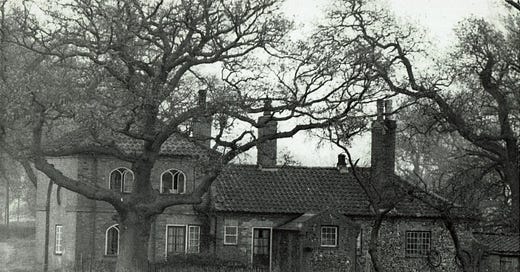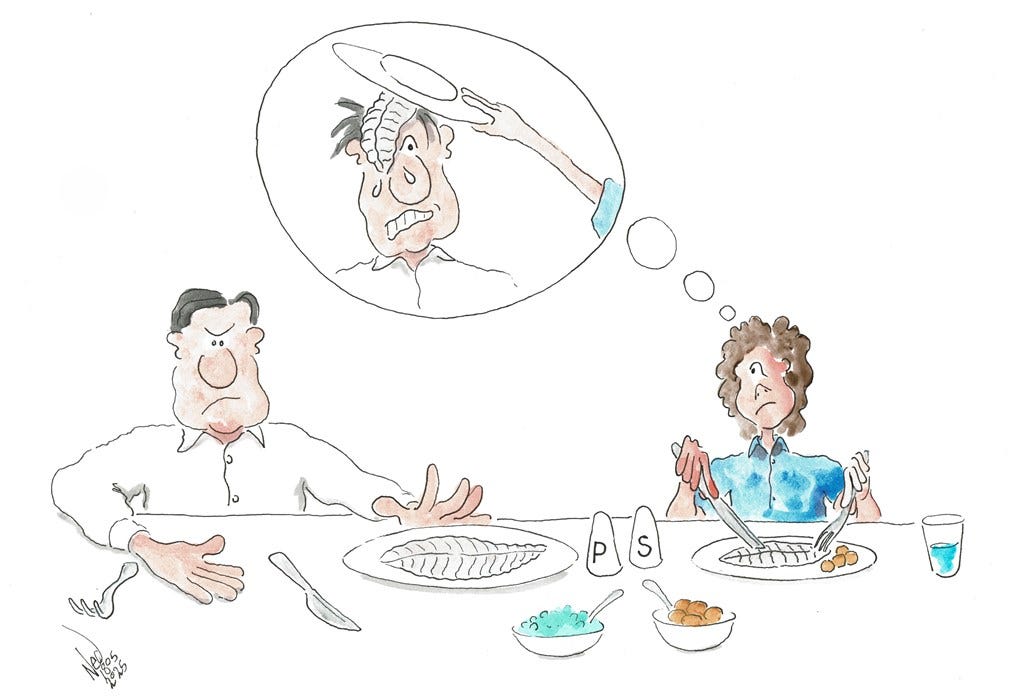Saving For A Village Hall
There was village cricket. The team consisted of members of three villages. The cricket playing green was in the grounds of the Hall and very good it was. Often the cricket team captain’s wife would make the sandwiches and cakes. They were chiefly for the players, but spectators had some as well. Anyone with spare time would come and watch. Dad played, but Mum could only watch on Sunday’s because she had the shop to attend. There was also a village meadow near the county bridge used at all sorts of times by different ages who came together and played rounders and football. After I’d left the village, this meadow was later used for cricket too.
It was decided to raise money to build a new village hall, the village school had doubled as such up to then. This led Mum to remark that the village people had raised money to buy the school piano and she wondered if that process had been recorded. Mum’s train of thought was if they had raised funds for a piano, they could do similar for a village hall. Fund raising for the new village hall began. Socials and whist drives made a profit, but a boost was needed. We had a fête in the grounds of the Hall. People from surrounding villages came and nearly the entire population of our three. It was a lovely day. The head teacher of the boarding school, as it was by then, opened it. I presented her with a bouquet of flowers. We, the students of the village school, performed a display of country dancing and at the end there was dancing on the lawn for all.
There was an untarred road way from our house to the village school which had been created by the estate. This road went past and between our house and garden and the rear of Barrack Yard houses opposite which were right on the road side for some of the way. After the houses came a grass verge backed by a stone wall about 5ft. high. The stone wall then met a white gate across the grass to a hedge. Often a white hunting horse lived in the meadow behind this gate. The hedge carried on most of the way to the village school. On our side of the road after our garden and fence came a bank and behind that a lilac hedge about 5ft. tall. The hedge and bank carried on and about a third of the way down this road was a wood for a hundred yards or so, then fields and meadow again until the school.
The road was stony and sandy, but in good repair as two or three men were employed to keep it so and the hedges trimmed. Meadows carried on apart from the Butler’s Cottage about halfway to the church and standing well back from the road up a driveway. Before the church came the garden of the rectory as it still is. Opposite the rectory garden there remains today a flint wall about 5ft tall which continues up to the Hall.
On the left Riddlesworth Hall was and is impressive with courtyard and lawns. Opposite to the side of the Hall is the church and rectory. Both have lots of ground. Beyond the rectory was the gardener’s house, greenhouses and lawns, all behind a flint pebble wall.
Back To The Village School
From here you could reach Knettishall by walking or cycling across the meadows. Over the river there was a very wide wooden bridge with sides about 4ft high. It was frequently used as it cut across a rectangle.
The village school doubled as our village hall until a new separate village hall was built. This is a later photograph c.1966.
The school had just one classroom, a fireplace, plenty of windows and a closed-in porchway. In the photo above you can see the classroom on the right-hand side with the porchway in front. The loos were at the far right end of the building in the photo along with the coal and tool sheds. The Governess’ house, left-hand in the photo, was at the other end of the building and I think had a kitchen, living room and probably two bedrooms. I never went in. I remember the Governess, as we called her, bring from her house hot bread and milk for a child who had come without breakfast.
Children came from all directions. The gamekeeper’s family walked through paths at the edge of fields, meadows and woods. Those from Riddlesworth came by road and pathway. From Knettishall they came from across the bridge or the longer route round by road. Gasthorpe children came along the road. As well as Governess Miss. Samples we had an infant teacher who cycled from Hopton. From wherever the cleaners came, they too cycled as did the people who came to whist drives, socials and meetings, all of whom required a light of some kind which had to be hooded during war time blackouts. At the socials we did country and ballroom dancing and bingo which we called housey-housey. The local gamekeeper ran the whist drives and bingo.
An important visit was the mobile library van, a local village service I use to this day. It brought books for adults and children. Children could go into the van to select, but it was rare for adults to do so as they would be otherwise occupied a distance away. The two teachers selected books for the adults. The adult books would then be fetched from and returned to the school. There may have been some book changing during social events. I know my parents borrowed books.
There was a small army camp at Riddlesworth, the other side of the village, and soldiers would come from there, probably in their uniforms, to social events.
After dusk at this time, we always had to be aware of not showing lights which may have been seen by enemy bomber aeroplanes, should they have come. We were very close to a large American aerodrome. Always the blackout was a priority. My father was a ‘special constable’ of some kind and one of his duties was to remind people of the blackout. All windows were covered in black, light-proof fabric. Doors had curtains to be pulled over when opened. Vehicle lamps were hooded. You even had to be careful walking with a torch. None of the cottages had running water since there was no mains water, and likewise neither gas nor electricity. We used candles inside, some oil lamps and later tilly lamps with glowing mantles. Our shop sold paraffin. I often had to fetch it for Mum. Someone would bring a metal can, a gallon I think. I would take it from the shop, through our living room, through another room and to a third room where the paraffin was kept. There was a large clothes boiler called a copper and at the opposite end by a window a large oil tank on a stand with a tap lower down, but high enough to allow a can to be placed beneath. I put the customer’s can under the tap until it was full, screwed the cap on and took it back through to the shop. I then went into the scullery to wash my hands since the paraffin was smelly. This might happen several times a day. Sometimes Mum would ask people to pick up their paraffin later if she was very busy. Oil lamps, candles and cleaning were part of living.
Once each fortnight an estate secretary would come to our house and use the front room to pay the estate workers. She and the employees would enter the front room through a door via the front garden. At some point my mother would take her tea and biscuits. Once they had all been and paid, the secretary would bid us farewell and go. It seemed to work well.
My Family
My mother’s grandfather was a gamekeeper, as were her father, uncle, brother and nephew. I knew her father, my Granddad. He was by then retired and lived with his daughter who tried very hard to please him. He appeared to find fault very readily. When I was staying with them, my aunt told me how my Granddad hated bones in his fish, so she always bought filleted pieces. Once when I was there we had fish which was delicious. We were all tucking when he, Granddad Dibbler as we called him, pushed his plate away saying he had found a bone and would eat no more. It made for an atmosphere and ruined the meal for all of us. At 10 years old I thought him an unreasonable, selfish old man and would have loved to have upended his plate on his head. Naturally, I made no comment and tried to be expressionless. I have no idea why he was called Dibbler and sad to say, I did not like that Grandfather very much. I never knew my other Grandfather, my father’s father.
Several years later when Dibbler appeared to be hail and hearty, he went to bed and said he wasn’t going to get up again. My auntie called the doctor who declared he could find nothing wrong. Granddad Dibbler had decided to die, wilful to the end.
On leaving the village school, somewhere in East Suffolk, Mum, Gladys Amelia Mayhew, had gone to work in the local post office. When she was 18 her mother died. I understand that she earned so little she was told by Dibbler that it was no longer possible to keep her at home, so she had to go into ‘service’ as a live-in maid. She often spoke of the friends she made there. One woman went in to make loose covers and became a life long friend.
She met Dad when she came to stay with cousins at Market Weston. Their father and hers were brothers, both gamekeepers. The uncle with whom she stayed could neither read nor write, but with his good memory easily held his job. It seems strange because the rest of the family was literate. Mum was bright. She had a brother who was killed in the 1914-18 war, another brother who was a game keeper and a sister who was a cook. In those days, Knettishall Red Arch was a popular meeting place for people on their bicycles. I think it quite likely Mum and her cousin went to The Red Arch and thereabouts found their way to Dad. I know Mum met Dad because he worked, very occasionally, at a saw bench in a nearby wood. If you start from Red Arch bridge, walk south, turn left at the 4-crossways, carry on until the first right, you come to where families Cursons, Fitches and Buxtons lived close to Home Farm, today called Hall Farm. In a wood up that little right-hand turn on the left was a circular saw bench in the open air. For whatever reason and however, Mum met Dad at that saw bench, so she said!
To be continued…
Previous post:
Gasthorpe Tales 005
https://gasthorpetales.substack.com/p/gasthorpe-tales-005





